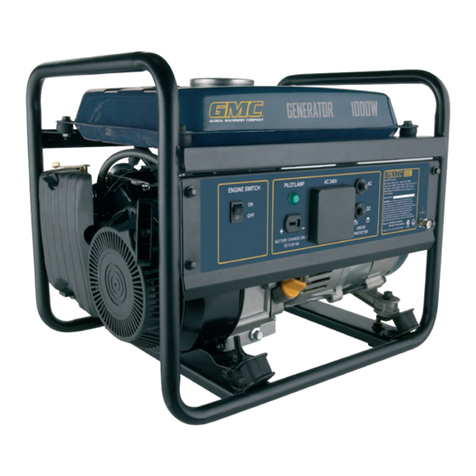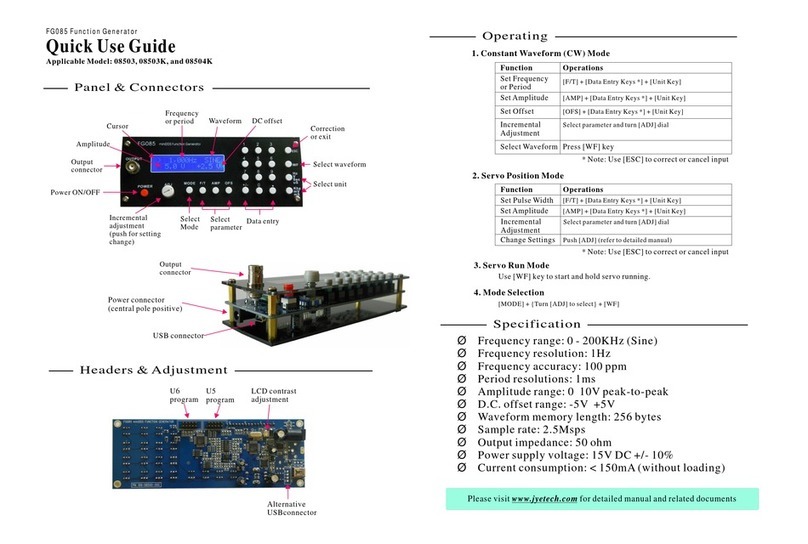EG&G ORTEC 416 User manual

INSTRUCTION
MANUAL
416
GATE
AND
DELAY
GENERATOR
Serial
No.
Purchaser
Date
Issued
COMPANY
100
MIDLAND
RDAD
OAK
RIDGE,
TENN.
37B30
PHONE—(615)
482-1QDB
TWX
810
-
572
-
1078
©ORTEC
Incorporated
1966
Printed
In
U.S.A.

TABLE
OF
CONTENTS
Page
WARRANTY
PHOTOGRAPH
1.
DESCRIPTION
1-1
2.
SPECIFICATIONS
2-1
3.
INSTALLATION
INSTRUCTIONS
3-1
3.1
General
3
-
1
3.2
Connection
to
Power
-
AEC
Standard
Nuclear
Instrument
Module,
ORTEC,
401A/402A
3
-
1
4.
OPERATING
INSTRUCTIONS
4-1
5.
CIRCUIT
DESCRIPTION
5-1
6.
MAINTENANCE
INSTRUCTIONS
6-1
6.1
Testing
Performance
6-
1
6.2
Calibration
Adjustments
6
-
1
7.
DC
VOLTAGE
MEASUREMENTS
7
-
1
8.
BIN/MODULE
CONNECTOR
PIN
ASSIGNMENTS
BLOCK
DIAGRAM
AND
SCHEMATIC
416-001-Bl
ORTEC
416
Block
Diagram
416-001-Sl
ORTEC
416
Schematic

LIST
OF
FIGURES
AND
ILLUSTRATIONS
Page
Figure
6-1.
Gate
and
Delay
Generator
-
Block
Diagram
6
-
1
Figure
6-2.
Delay
Stability
Versus
Temperature
Curves
6-2

F
w
A
NEW
STANDARD
TWO-YEAR
WARRANTY
FOR
ORTEC
ELECTRONIC
INSTRUMENTS
ORTEC
warrants
its
nuclear
instrument
products
to
be
free
from
defects
in
workmanship
and
materials,
other
than
vacuum
tubes
and
semiconductors,
for
a
period
of
twenty-four
months
from
date
of
shipment,
provided
that
the
equipment
has
been
used
in
a
proper
manner
and
not
subjected
to
abuse.
Repairs
or
replacement,
at
ORTEC
option,
will
be
made
without
charge
at
the
ORTEC
factory.
Shipping
expense
will
be
to
the
account
of
the
customer
except
in
cases
of
defects
discovered
upon
initial
operation.
Warranties
of
vacuum
tubes
and
semiconductors,
as
made
by
their
manufacturers,
will
be
extended
to
our
customers
only
to
the
extent
of
the
manufacturers'
liability
to
ORTEC.
Specially
selected
vacuum
tubes
or
semiconductors
cannot
be
warranted.
ORTEC
reserves
the
right
to
modify
the
design
of
its
products
without
incurring
responsibility
for
modification
of
previously
manufactured
units.
Since
installation
conditions
are
beyond
our
control,
ORTEC
does
not
assume
any
risks
or
liabilities
associated
with
methods
of
installation
other
than
specified
in
the
instructions,
or
installation
results.
QUALITY
CONTROL
Before
being
approved
for
shipment,
each
ORTEC
instrument
must
pass
a
stringent
set
of
quality
control
tests
designed
to
expose
any
flaws
in
materials
or
workmanship.
Permanent
records
of
these
tests
are
maintained
for
use
in
warranty
repair
and
as
a
source
of
statistical
information
for
design
improvements.
REPAIR
SERVICE
ORTEC
instruments
not
in
warranty
may
be
returned
to
the
factory
for
repairs
or
checkout
at
modest
expense
to
the
customer.
Standard
procedure
requires
that
returned
instruments
pass
the
same
quality
control
tests
as
those
used
for
new
production
instruments.
Please
contact
the
factory
for
instructions
before
shipping
equipment.
DAMAGE
IN
TRANSIT
Shipments
should
be
examined
immediately
upon
receipt
for
evidence
of
external
or
concealed
damage.
The
carrier
making
delivery
should
be
notified
immediately
of
any
such
damage,
since
the
carrier
is
normally
liable
for
damage
in
shipment.
Packing
materials,
waybills,
and
other
such
documentation
should
be
preserved
in
order
to
establish
claims.
After
such
notification
to
the
carrier,
please
notify
ORTEC
of
the
circumstances
so
that
we
may
assist
in
damage
claims
and
in
providing
replacement
equipment
if
necessary.

MODEL
416
GATE
AND
DELAY
GENERATOR
DELAY
RANGE
0.1-1.1
DELAY
1.0-11
■
(jlSEC
■
u
WIDTH
AMPLITUDE
0.4
4.0
2.5
10
/xSEC
VOLTS
INPUT
DELAY
DLY'D
PERIOD
MARKER
O
4t
■OUTPUT-
POS—
DLY'D
GATE—NEG
OUTPUT-
-fI2V
85mA
-I2V
50mA
-P24V
45mA
~24V
35mA

1
-
1
ORTEC
416
GATE
AND
DELAY
GENERATOR
1.
DESCRIPTION
The
416
Gate
and
Delay
Generator
is
one
in
a
series
of
modular
instruments
com
plying
with
the
AEG
Nuclear
Instrument
Module
Standards.
This
module
is
de
signed
to
provide
the
interface
functions
for
logic
pulses
between
the
logic
pulse
generation
and
its
end
use.
These
necessary
functions
ore:
variable
delay,
vari
able
pulse
amplitude,
variable
pulse
width,
and
a
selection
of
output
polarity.
The
uses
for
the
unit
will
include
such
applications
as
analyzer
gating
and
coinci
dence
trigger
circuits,
and
others.
Due
to
its
unique
design,
it
also
provides
timing
signals
which
are
suitable
for
driving
time
to
pulse
height
converters
or
coincidence
circuits
in
delayed
coincidence
applications
such
as
pulse
shape
dis
crimination,
etc.
I

2-
1
2.
SPECIFICATIONS
Delay
Ranges
Delay
Adjustmenl-
Delay
Readout
Delay
Linearity
Delay
Temperature
Stability
Delay
Generator
Dead
Time
Gate
Generator
Dead
Time
Count
Rote
Delay
Jitter
Input
Input
Impedance
Output
Impedance
Delay
Period
Delay
Marker
Delayed
Gate
Power
Requirements
0.1
psec
to
1,1
psec
1.0
psec
to
11
psec
Continuously
variable
within
the
selected
range
by
means
of
a
10-turn
potentiometer
Direct
reading
via
a
10-turn
dial
±2%
sO.03%
of
selected
range
Delay+0.1
range
Gate
pulse
width
+0.2
psec
l/dead
time
^0.02%
of
range
at
average
dead
time
<20%
Pos.,
2V
min.,
protected
to±100Vmax.,
dc-coupled,
non-critical
to
rise
time,
25
nsec
minimum
width
s
1
K
ohm
Less
than
10
ohms
for
all
outputs
Tp
<50
nsec,
positive,
4V,
width
equal
to
delay
time
Tp
<10
nsec,
negative,
0.6V,
width
<25
nsec
Positive
and
negative
simultaneously;
amplitude
variable
2.5V
to
lOV,
width
variable
0.4
psec
to
4
psec;
T^.
<100
nsec
+24V
~
45mA
-24V
~
35mA
+12V
~
85mA
-12V
~
50mA

p
3
-
1
3.
INSTALLATION
INSTRUCTIONS
3.1
General
The
ORTEC
416,
used
in
conjunction
with
the
ORTEC
401A/402A
Bin
and
Power
Supply,
is
intended
for
rock
mounting;
therefore,
it
is
necessary
to
ensure
that
vacuum
tube
equipment
operating
in
the
same
rack
has
sufficient
cooling
air
circulating
to
prevent
any
localized
heating
of
the
oM-tronsistor
circuitry
used
throughout
the
416.
The
temperature
of
equipment
mounted
in
rocks
can
easily
exceed
the
recommended
maximum
unless
precautions
ore
token.
The
416
should
not
be
subjected
to
temperatures
in
excess
of
120°F
(50®C).
3.2
Connection
to
Power
—
AEC
Standard
Nuclear
Instrument
Module,
ORTEC
401iV402A
The
416
contains
no
internal
power
supply;
therefore,
it
must
obtain
power
from
a
Nuclear
Standard
Bin
and
Power
Supply
such
as
the
401A/402A.
It
is
recommended
that
the
Bin
power
supply
be
turned
off
when
inserting
or
re
moving
modules.
The
ORTEC
400
Series
is
designed
so
that
it
is
not
possible
to
overload
the
Bin
power
supply
with
a
full
complement
of
modules
in
the
Bin;
however,
this
may
not
be
true
when
the
Bin
contains
modules
other
than
those
of
ORTEC
design.
In
this
cose,
power
supply
voltages
should
be
checked
after
the
insertion
of
modules.
The
401A/402A
has
test
points
on
the
power
supply
control
panel
to
monitor
the
dc
voltages.

4-
1
4.
OPERATING
INSTRUCTIONS
The
operation
of
the
416
should
be
very
simple
and
straightforward.
Once
it
is
plugged
in
and
the
power
turned
on,
it
is
necessary
only
to
furnish
a
trigger
pulse
of
sufficient
amplitude
to
trigger
it,
select
the
desired
range
of
delay,
then
dial
in
the
approximate
delay
wanted,
and
connect
the
desired
output
to
the
input
of
the
circuit
that
it
is
to
drive.
For
instance,
if
one
wishes
to
gate
an
analyzer
which
requires
an
0.8-microsecond
delay
and
a
negative
4-volt
signal
2
microsec
onds
wide,
connect
the
negative
delayed
output
to
the
gating
input
to
the
analyzer,
set
the
delay
range
to
the
0.1
psec
to
1.0
psec
position,
and
dial
the
delay
poten
tiometer
to
800
on
the
10-turn
dial.
Set
the
width
potentiometer,
R28,
at
approxi
mately
midrange
and
the
amplitude
potentiometer,
R24,
at
approximately
one-third
range.
Of
course,
to
set
the
width
and
amplitude
precisely
one
must
view
these
with
an
oscilloscope.
Also,
the
real
time
delay
is
not
meant
to
be
correlated
close
ly
enough
with
the
dial
reading
to
be
believed
better
than
±5
percent;
however,
the
reproducibility
of
the
delay
should
be
very
good.
Therefore,
if
one
wishes
to
plot
the
delay
function
versus
dial
reading,
he
should
be
able
to
determine
his
delay
precisely
at
any
time
thereafter.
In
almost
all
instances,
care
should
be
taken
to
see
that
the
connecting
cables
used
are
terminated
in
their
characteristic
impedances.
In
the
case
of
the
DELAYED
GATE
output,
this
is
not
quite
so
critical
as
it
is
in
the
case
of
the
DELAY
PERIOD
and
the
DELAYED
MARKER;
however,
if
pulse
fidelity
is
a
requirement,
this
precaution
should
be
observed
also
on
the
DELAYED
GATE
outputs.

5
-
1
5.
CIRCUIT
DESCRIPTION
Diodes
D6
and
D7
form
o
current
limiting
protection
circuit
to
protect
against
large
amplitude
signals.
Q13,
Q14,
and
Q15
form
a
dc-coupled
Schmitt
trigger
which
has
fast
rise-time
and
a
width
equal
to
the
width
of
the
input
signal.
The
current
pulse
at
the
collector
of
Q14
is
differentiated
by
L2.
D1,
in
turn,
clips
the
negative
portion
of
the
differentiated
pulse
and
passes
the
positive
portion
to
the
base
of
Q1
.
The
positive
portion
of
the
pulse
triggers
the
delay
multivibrator,
which
is
composed
of
Ql,
Q2,
Q3,
and
Q4.
When
triggered,
this
multivibrator
sets
a
voltage
step
onto
a
capacitor,
either
C4
or
C5,
and
then
this
capacitor
is
discharged
with
a
constant
current
which
is
furnished
by
way
of
Q4
and
is
con
trolled
by
the
delay
potentiometer,
R11
.
Since
it
is
a
constant
current
discharge,
the
delay
will
be
linear.
Diode
D2
provides
the
dc
bias
necessary
to
hold
Q2
in
the
conduction
state
until
the
multivibrator
is
triggered,
at
which
time
the
voltage
pulse
from
the
emitter
of
Q3
is
fed
over
to
cut
off
the
diode.
It
will
remain
off
until
the
multivibrator
recovers.
D3
provides
a
dc
restoration
for
the
capacity
coupling
by
C3
of
the
output
pulse
from
the
delay
multivibrator.
This
output
pulse
is
emitter-follower
buffered
through
Q5
and
is
called
the
DELAY
PERIOD
output.
The
DELAY
PERIOD
output
pulse
is
differentiated
by
means
of
LI,
and
the
differen
tiated
pulse
is
fed
to
the
base
of
Q6,
which
is
normally
off
emitter
follower,
but
the
negative
portion
which
occurs
at
the
trailing
edge
of
the
DELAY
PERIOD
pulse
will
be
fed
out
as
a
DELAY
MARKER
pulse.
When
06
conducts,
it
furnishes
the
DELAY
MARKER
pulse
at
the
output
and
an
inversion
of
the
DELAY
MARKER
pulse
at
its
collector
which
is
ac-coupled
to
the
base
of
07.
This
pulse
triggers
the
gate
pulse
generator
composed
of
Q7,
Q8,
and
Q9.
When
the
gate
pulse
generator
is
triggered,
the
constant
current
that
is
flowing
through
Q8
will
be
switched
through
07,
and
an
output
pulse
which
is
the
constant
current
multiplied
by
the
sum
of
R25
and
the
amplitude
control,
R24,
will
be
fed
to
the
base
of
OlO,
and
is
the
generation
of
the
gate
pulse.
Again,
D5
forms
a
dc
restoration
for
the
capacity
coupling
of
C12.
O10
is
a
phase
splitter
which
forms
two
pulses
of
equal
amplitude
but
opposite
polarity.
The
positive
pulse
is
fed
to
the
base
of
011
and
the
negative
to
the
base
of
Q12.
Ql
1
and
Q12
are
an
NPN
and
PNP
pair
that
are
both
in
the
cut-off
state
until
the
gate
pulse
arrives,
at
which
time
they
turn
on
for
the
period
of
the
gate
pulse
and
present
an
output
at
their
respective
output
connectors.
The
gate
pulse
width
is
controlled
by
the
RC
combination
composed
of
C11
and
the
series
resistance,
R29
and
R28.
R28
is
the
GATE
WIDTH
control.
W

6
-
1
6.
MAINTENANCE
INSTRUCTIONS
6.1
Testing
Performance
To
te
st
the
operation
of
this
unit,
first
test
the
operation
of
the
delay
multi
vibrator
section.
To
do
this,
merely
insert
on
input
trigger
pulse
and
check
for
on
output
from
the
DELAY
PERIOD
output.
Monitor
the
width
of
the
DELAY
PERIOD
output,
vary
the
delay
potentiometer,
R11,
through
its
range,
and
also
check
the
operation
of
the
RANGE
SELECTOR
switch,
SI
.
Of
course,
this
pulse
width
should
be
equal
to
the
desired
delay
time
except
for
a
small
propagation
delay
of
about
25
nanoseconds.
With
the
trigger
present,
if
there
is
no
DELAY
PERIOD
output,
the
trouble
is
immediately
isolated
to
the
delay
multivibrator.
Usually
the
first
test
to
perform
is
that
of
measuring
dc
voltages
and
comparing
them
with
the
voltages
given
in
Table
1.
If
this
does
not
isolate
the
trouble,
then
one
must
resort
to
the
use
of
on
oscilloscope
and
waveform
checks.
Sufficient
waveforms
for
comparison
ore
given
on
the
schematic
diagram,
drawing
number
416-001-51,
in
the
back
of
the
manual.
If
the
DELAY
PERIOD
output
pulse
is
present,
check
for
on
output
from
the
DELAYED
MARKER
output
BNC.
If
the
DELAYED
MARKER
output
does
not
exist,
then
the
problem
is
immediately
isolated
to
the
circuit
surrounding
Q6.
If
a
DELAYED
AAARKER
output
exists
but
there
is
no
gate
pulse
output,
this
of
course
indicates
that
the
gate
multivibrator
is
not
being
correctly
triggered.
Again,
the
best
test
is
a
dc
voltage
measurement
test
and
comparison
against
the
tabulated
voltages.
6.2
Calibration
Adjustments
There
ore
no
calibration
adjustments
in
the
Gate
and
Delay
Generator
itself;
only
the
adjustments
which
are
available
at
the
front
panel
are
variable.
DELAY
PERIOD
J
\Z3-^y.
J
DELAY
J
MARKER
OATL
GEN.
'I
GEN.
PULSE
GEN.
^
(i)
delay
v.^-\
[
^marker
DELAYED
OA-4m
sec
®
i_jfp
Figure
6-1.
Gate
and
Delay
Generator
-
Block
Diagram

6-2
h-
Uj
ki
Qi
Q
k
O
k
S
o
tt
O.k
0.5
0.4
0.3
0.2
0.1
0
0.1
0.2
0.3
0.4
0.5
0.6
\
\
\
\
\
\
\
\
\
\
\
\
\
\
-
-
-
\
\
/
/
/
X/
y
\
\
N
//
/
/
/
/
>
//
/
/
/
-
DELAY
=
full
range
-DELAY
=
1/E
RANGE
-DELAY-
l/t).
RANGE
-DELAY
=
1/10
RANGE
5
10
15
20
25
30
35
40
45
50
55
GO
TEMPERATURE
(Degrees
Centigrade
)
Figure
6-2.
Delay
Stability
Versus
Temperature
Curves

7
-
1
Table
1,
DC
Voifoge
Measurements
Checkpoint
Average
Values
+
12
bus
+11.8
+
24
bus
+23.8
-24
bus
-23.6
-12
bus
-11.7
Q2-B
+
0.70
Q2-C
+
5.0
Q3-B
+11.5
Q4-B
+21.5
Q5-B
-
0.60
Q6-C
-11.8
Q8-B
+
0.60
Q8-C
Amp
Pot
Min
+9.4
Q8-C
Amp
Pot
Max
+
0.50
Q9-E
+12.4
QID-B
-
0.25
QIO-E
+
0.50
*Q10-C
-
0,45
Qll-E
+
0.1
Q12-E
-
0.1
Q13-B
+
0.1
Q14-B
'
+
1.8
Q15-E
+12.5
*
R
33
to
be
selected,
if
necessary.
Nominal
22
Q
Note:
All
voltages
are
read
with
respect
to
ground
with
a
vtvm,
with
no
signal
input,
and
with
all
front
panel
pots
in
the
zero
position.

BIN/MODULE
CONNECTOR
PIN
ASSIGNMENTS
FOR
AEC
STANDARD
NUCLEAR
INSTRUMENT
MODULES
PER
TID-20893
Pin
Function
Pin
Function
1
+3
volts
23
Reserved
2
—3
volts
24
Reserved
3
Spore
Bus
25
Reserved
4
Reserved
Bus
26
Spare
5
Coaxial
27
Spare
6
Coaxial
♦28
+24
volts
7
Coaxial
♦29
—24
volts
8
200
volts
dc
30
Spore
Bus
9
Spare
31
Carry
No.
2
♦10
+6
volts
32
Spore
*11
—6
volts
CO
CO
115
volts
ocC^^O
12
Reserved
Bus
♦34
Power
Return
Groundi
13
Carry
No.
1
35
Reset
14
Spare
36
Gate
15
Reserved
37
Spore
*16
+12
volts
38
Coaxial
♦17
—12
volts
39
Coaxial
18
Spore
Bus
40
Coaxial
19
Reserved
Bus
*41
115
volts
oc
(Neut.)
20
Spore
♦42
High
Quality
Ground
21
Spore
G
Ground
Guide
Pin
22
Reserved
*These
pins
are
installed
and
wired
in
parallel
in
the
ORTEC
401A
Modular
System
Bin.
u

The
transistor
types
instalied
in
your
instrument
may
differ
from
those
shown
in
the
schematic
diagram.
In
such
cases,
necessary
replace
ments
can
be
made
with
either
the
type
shown
in
the
diagram
or
the
type
actually
used
in
the
instrument.
Table of contents
Popular Portable Generator manuals by other brands

Winco
Winco WL22000VE/B Installation & operator's manual

Coleman
Coleman Powermate PM Series Operator's manual
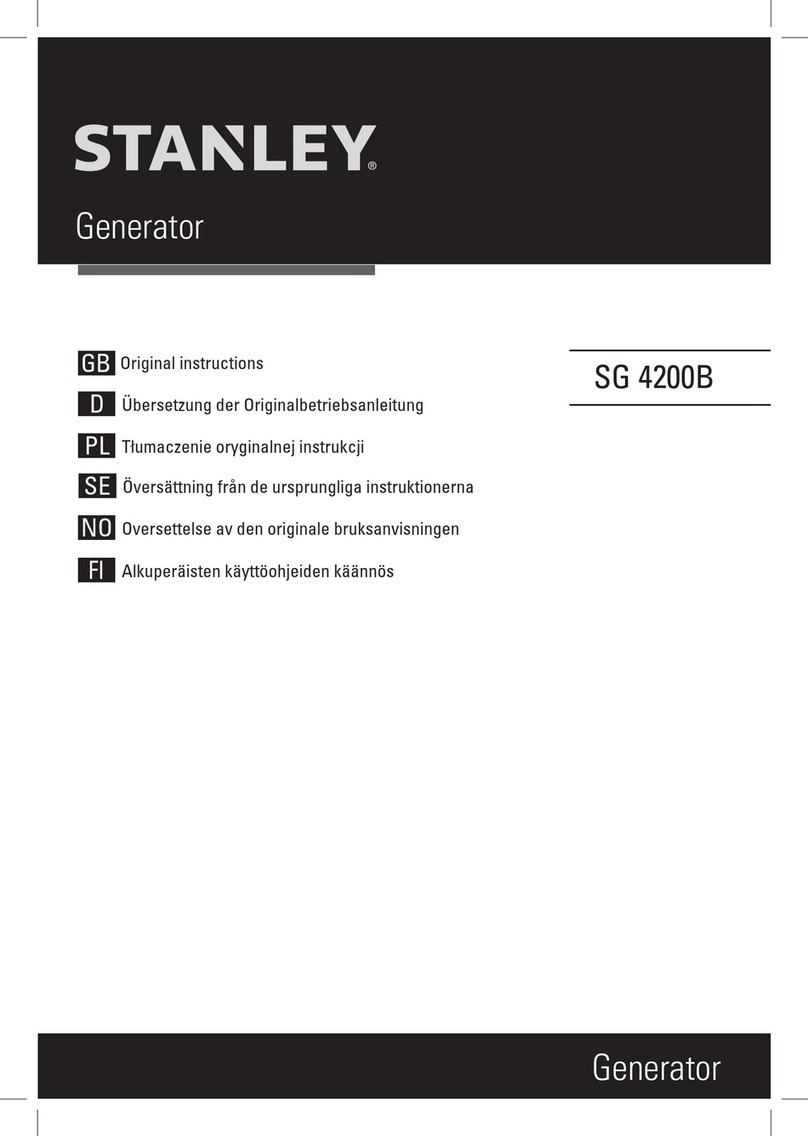
Stanley
Stanley SG 4200B Original instructions
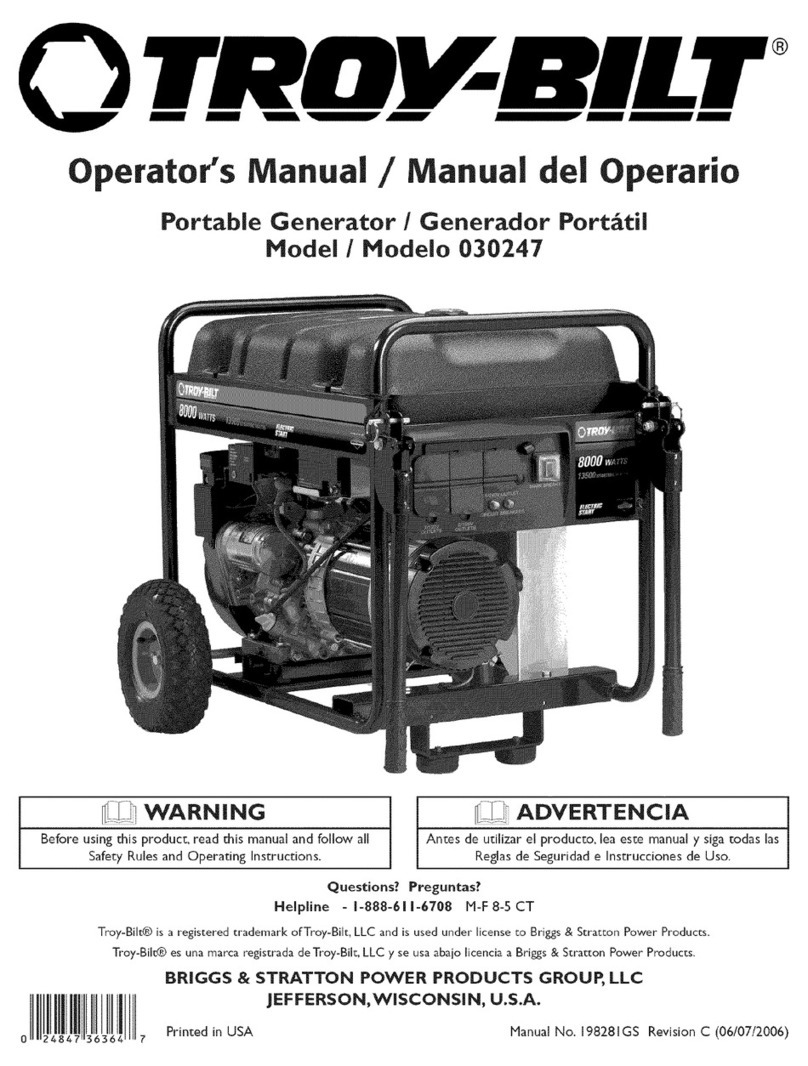
Troy-Bilt
Troy-Bilt 30247 Operator's manual

Southwest Windpower
Southwest Windpower Whisper H-80 owner's manual

SDMO
SDMO Diesel 6000 E XL C Instruction and maintenance manual

Briggs & Stratton
Briggs & Stratton 030694-00 Operator's manual

Senci
Senci SCDE19i-YS user guide

Ribimex
Ribimex PRGE0800 User and maintenance manual
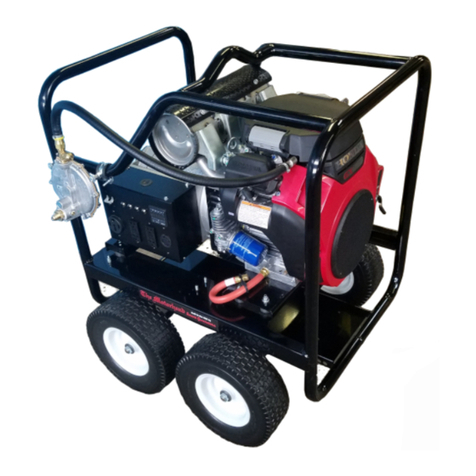
Smart Generators
Smart Generators Motorhead Plus SG13001 operating instructions

Stanley
Stanley SIG 1200S Original instructions

Troy-Bilt
Troy-Bilt 1923 owner's manual



